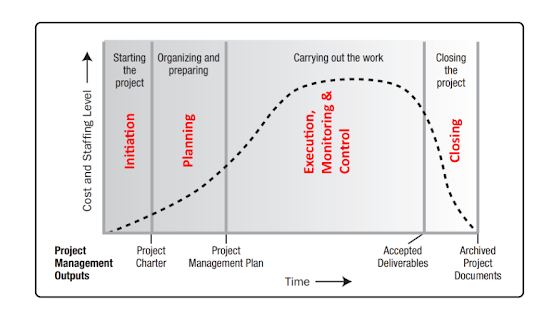The project's activities and resource requirements are identified, along with the production strategy. The Project Plan is created outlining the activities, dependencies, and timeframes. The Project Manager coordinates the project budget preparation by providing cost estimates for the labor, equipment, and material cost.
The budget is used to monitor and control cost expenditures during Project Execution.
- Identify the work/task
- Prepare the schedule
- Estimate the costs
Identify and deal with anything that might threaten the successful completion of the project. This is called risk management.
Risk Management, such as "high-treat" potential problems, is identified along with the action taken on each "high-threat" potential issue. To reduce the probability that the problem will occur or minimize the impact that the problem impacts the project if it happens.
This is also the time to document all the project stakeholders and establish a Communication Plan describing the information needed and the delivery method to keep the Stakeholders informed. To ensure a successful project, we may have to document the resource plan to identify the materials, supplies, services, and personnel.
The Resources Plan includes a team plan that documents the availability of the team and how we will create a positive team environment.
Procurement Plan if we plan to produce services or materials. Finally, we will want to document a Quality Plan, providing quality targets, assurance, control measures, and an Acceptance Plan, listing the criteria to be met to gain customer acceptance. At this point, the project would have been planned in detail and is ready to be executed.
Execution Phase (Including Monitoring and Control):
Progress is continuously monitored, and appropriate adjustments are made and recorded as variances from the original plan. A project manager spends most of the time in this project phase. During project execution, people carry out the activities, and progress information is reported through regular meetings. The Project Manager uses this information to maintain control over the direction of the project activities and take corrective action as needed.
The first course of action is to return the project to the system (i.e., return it to the original plan). If that cannot happen, the team should record variations from the original intent and video and publish modifications to the program. Throughout these steps, Project Sponsors and other vital Stakeholders should be kept informed of the project status according to the agreed-on frequency and format of communication.
Status reports should always emphasize the anticipated endpoint in terms of cost, schedule, and quality of deliverables. Each produced project should be reviewed for quality and measured against the acceptance criteria. Once all deliverables have been made, and the customer has accepted the final solution, the project is ready for Closure.
Closing Phase:
Releasing the final deliverables to the customer, handing over project documentation to the business, terminating supplier contracts, releasing and reassigning project resources to other work or projects, and communicating the closure of the project to the Stakeholders.
The last remaining step is to conduct lessons-learned studies in a post-project review to examine what went and didn't. Through this type of analysis, the wisdom of the experience is transferred back to the project organization, which will help future project teams.
Project Management Institute Definitions
The Project Management Institute (PMI) defines a difference between the definition of a Project Phase and Project Management Process Groups.
A Project Phase is a "collection of logically related project activities that culminates in a completion of one or more deliverables". PMI defines the generic phases of a project as Starting the Project, Organizing and Preparing, Carrying Out the Work, and Ending the Project. Within the generic phases of a Project Cycle, PMI has defined the generic phases a project as Starting the Project, Organizing and Preparing, Carrying Out the Work, and Ending the Project. Within the generic phases of a Project Life Cycle, PMI has defined five Progress Groups.
Here are the PMI definitions of each of the Project Management Process Groups.
Initiating Process Group: "Those processes performed to define a new project or a new phase of an existing project by obtaining authorization to start the project or phase".
Planning Progress Group: "The processes required to establish the scope of the project, refine the objectives, and define the course of action required to attain the objectives that the project was undertaken to achieve."
Executing Process Group: "Those processes performed to complete the work defined in the project management plan to satisfy the project requirements."
Monitoring and Controlling Process Group: "Those processes required to track, review and regulate the progress and performance of the project: identify any areas in which changes to the plan are required, and initiate the corresponding changes."
Closing Process Group: "The process(es)performed to formally complete or close a project, phases, or contract."
*References:
This material is a derivative copy of:
Barron, Merrie, and Andrew Barron. "Chapter 9: The Project Life Cycle" in Project Management. (2016)
Used under CC BY-NC-SA 4.0 (https://creativecommons.org/licenses/by/4.0/)
Darnall, Russel, and John Preston "Chapter 3.1: Project Phases" in Project Management Form Simple to Complex. (University of Minnesota Libraries Publishing, 2016).
Used under CC BY-NC-SA 4.0
Project Management Institute. A Guide to the Project Management Body of Knowledge (PMBOK Guide). 7th ed. (Newtown Square, PA: Project Management Institute Inc., 2021), 205 Copyright and all rights reserved.
Summary of a Life cycle Phases
Read Chapter 3, of the Project Management Open Textbook
https://opentextbc.ca/projectmanagement/chapter/chapter-3-the-project-life-cycle-phases-project-management/







Comments
Post a Comment